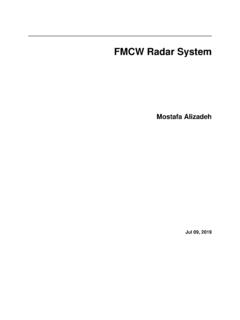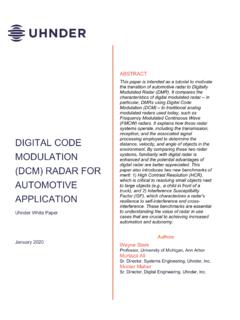Transcription of Radar & LiDAR Autonomous Driving Sensors by ... - Mobileye
1 Mobileye has revolutionized computer vision algorithms for Autonomous Driving . Now, Mobileye and Intel are revolutionizing Radar and LiDAR with new Sensors developed specifically for self- Driving applications. Ultimately, this paves the way for the most robust way to achieve True Redundancy via multiple sensor subsystems for environmental modelling for AVs. What are Mobileye and Intel s new Radar & LiDAR Autonomous Driving Solutions? A new take on Radar & LiDAR which leverage the latest technology in both areas, specifically designed to meet self- Driving applications. Traditional Radars and LiDARs have limitations when it comes to the environmental modelling needed for AVs, and new approaches and innovations have opened the door to more accurate and cheaper ways to achieve the technological goals to enable AVs.
2 Why is this necessary?The hardware needed for consumer AVs is cost prohibitive based on the current approaches and available Sensors . A simple reality is that Radars are 10 times cheaper than LiDARs. Solutions are needed to make Radars and LiDARs both better and cheaper. To reach L5 autonomy we propose: Three levels of redundancy in the forward-facing field of view (FoV), and for the rest of the FoV, 2 levels of redundancy. Ultimate goal to reach cost-efficient True Redundancy for consumer AVs: 360 camera coverage 360 Radar cocoon 1 forward-facing LiDARR adar & LiDAR Autonomous Driving Sensors by Mobileye & IntelNext Generation Active Sensor Development Intel has the know-how to build the cutting-edge of Radars and LiDARs.
3 Prof. Amnon SHEETNext-gen Radar - LiDAR Subsystem:360 Radar Cocoon + 1 Front-facing SHEETWhat s new about the Radars being developed? What s new about the LiDARs being developed? For a deep dive on Mobileye s Radar and LiDAR development watch Mobileye CEO, Prof. Amnon Shashua s virtual CES address Under the Hood with Amnon in full here. Goal: Solve for: angular resolution, dynamic range, and the side lobes effectHow: Paradigm shift in architecture to enable a leap in performance Digital and software-defined imaging Radar with a state-of-the-art RFGoal: Solve for: range limitations, interferences, and target velocity measurementHow: Build the best-in-class FMCW LiDAR Harness Intel s Silicon Photonics leadershipWhy are Intel & Mobileye well-positioned to tackle this challenge?
4 Intel has impressive expertise in cutting-edge sensor solutions in both in Microwave and Millimeter Wave (mmWave) radio frequency (RF), Silicon Photonics and signal processing algorithms, required for imaging Radars and high end LiDARs. While the notion of Frequency-Modulated Continuous Wave (FMCW) LiDARs is not new in academic circles and a small number of startups are developing such technology, Intel s silicon photonics experience considerably enhance the realization and productization of this technology at high volume and reliability. In fact, Intel owns a unique Fab capable of putting active and passive optical elements on a chip together, including lasers and optical amplifiers, loaded onto a photonic integrated circuit, PIC.
5 The group is led by Sagi Ben Moshe, Mobileye s Senior VP for Sensor Technologies and Chief Incubation Officer, CVP and GM Emerging Growth and Incubation at Intel. When will this be ready? We are targeting 2025. Until 2022, we will be using best-in-class LiDARs from Luminar Technologies, Inc. and advanced stock Radars. In the mean time, Intel and Mobileye are pushing the cutting-edge of these technologies to get them ready to enable highly accurate and cost effective Autonomous FMCW LiDARTyp. LiDARR ange ResolutionRobustness to InterferencesVelocity DetectionNight OperationRange & Field of viewDevice CostAngular ResolutionAdverse WeatherDetecting motorcycles beyond 200m4D (+Doppler for relative velocity measurement)Contour detection 500K PPS 300m max.
6 Range 1/R decayDetecting remote low RCS targets in presence of strong close targetsHigh immunity to interference through coherent detectionHazard cue detecting a rimless tire @ 130mMaintaining high res. sampling 2M PPS 600 pts per degree2 Implications:Implications.

